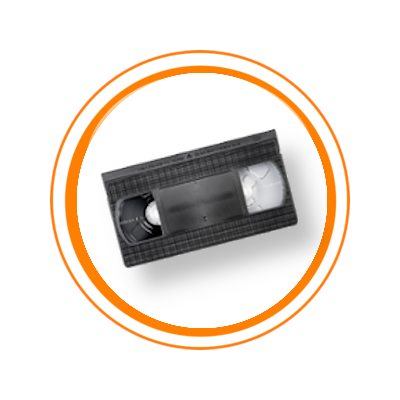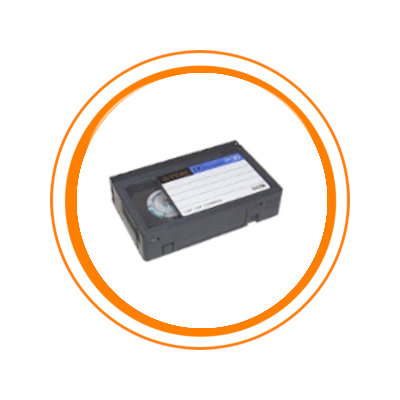Here at Orion Media we can convert all video and camcorder tapes to a digital format, such as a DVD disc or USB Memory stick or even a digital format to upload to the cloud using google drive etc. But what format tapes to you have exactly? Here is a run down of the most common consumer video tape formats.
VHS
The most common of all video tapes VHS revolutionised the home entertainment market in the 1980’s. These were pretty much the earliest form of video tape, with bulky cameras having a large VHS tape directly inserted into them. Convenient yes, but a monster to carry around and very expensive.
VHS-C
VHS-C which stands for VHS-Compact uses the same size magnetic tape but in a much smaller housing. They would typically last around 30-45 minutes and were hugely popular in the 1990’s. This smaller format made consumer cameras much smaller and much more affordable. They had a simple but ingenious design feature. The smaller VHS-C tapes could be inserted into a VHS sized device which allowed the smaller tape to be inserted direct into VHS players just like an ordinary VHS tape. No conversion necessary. Despite most of these tapes which come in to our shop being 20-30 years old the picture quality is often exactly the same as when they were originally captured decades ago.
8mm Tapes
Developed towards the end of the 1990’s this tape is smaller in width than the VHS format, being 8mm wide. They have a higher quality image and were longer than VHS-C tapes with the typical tape being 60-90 minutes long. These cameras were even smaller than the larger VHS-C cameras. The drawback was the tape had to be played back in the original camera, and could not be inserted directly into the VHS players using the VHS-C converter.
Hi-8 Tapes
Hi-8 stands for Hi-Band Video8 and was introduced by Sony as a rival to the S-VHS tapes (Super-VHS). Both are comparable in terms of resolution but Hi-8 easily beat S-VHS with a lower price and the marketing power of Sony. The improved picture and sound is comparable to laserdisc technology.
Mini-DV
These are the first digital technology consumer format tapes to be introduced. They became popular in the 2000’s. Their smaller size format, both in magnetic tape size, being less than half the width of 8mm tape, and the physical size of the tape proved very popular with mini-dv cameras being the first palm sized camcorders. The digital video and sound was an improvement on the analog format. This digital format also allowed digital transfer from the tape to a computer, which improved the overall quality as there was no loss of signal as there is with analog. It was important to use cleaning tapes on these cameras as dirty heads could cause the picture and sound to pixelate and break up.
Digital-8
Not very common compared to Mini-DV tapes and analog 8mm tapes, they lost out due to the introduction of the more convenient Mini-DV format. We do have the equipment to transfer these to DVD/USB so even if you no longer have the camera or a working camera please do bring them in to our shop and we can transfer them to DVD.
Cine Films
Not technically tapes they are worth a mention as we do transfer cine films to DVD or a USB memory stick. The home consumer started to use these in the 1950’s and 1960’s to capture birthdays, Christmases and holidays. Typically a small 25 feet reel would be placed into the camera, and when the end was reached you would turn it over and run it through again. The reel would then be split and developed by the processor and returned as one 50 feet reel. A 50 feet reel of 8mm cine film is approximately 3-4 inches in diameter. Many people would then edit and join these reels together to form larger reels of continuous film. 95% of the cine films we get are silent so we like to add some background music that complements the scene.


















4 comments
Hi,I have 3 videos,and 23 hi 8 cassettes I would like transferred to memory stick please,nor all tapes are fully recorded on,how much please,and is there discount on bulk offers.thanks
If you have over 10 tapes the price is £1 less, so £60 for ten tapes to DVD, or £110 for ten tapes to USB (includes a free set of DVDs).
a few years ago you transfered a few vhs tapes to dvd for me, and thet are still in regular use. Can you tell me if you can transfer 35mm slides to DVD and if so how much does it cost? I have a considerable number of these slides. yours sincereley John Jackson
Yes we transfer slides to DVD. We scan them into digital photos which you can print/email/view on your computer and we can also convert it to a DVD for viewing on your TV. https://oriondvd.co.uk/digitise-slides/